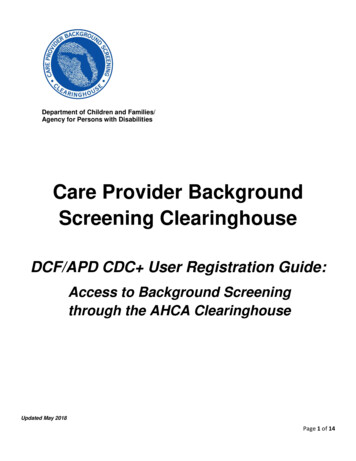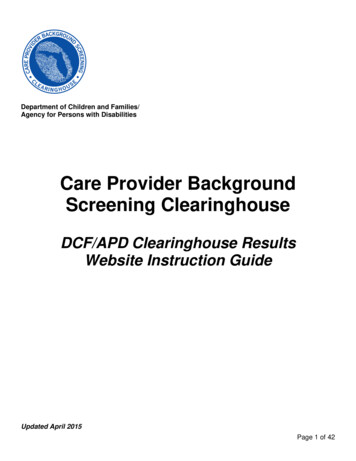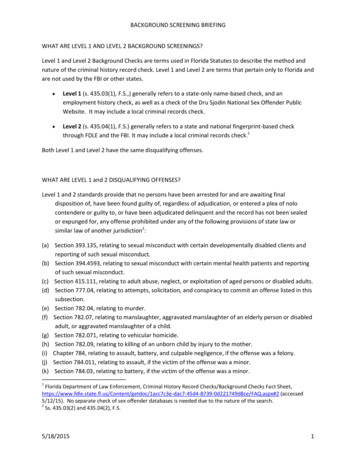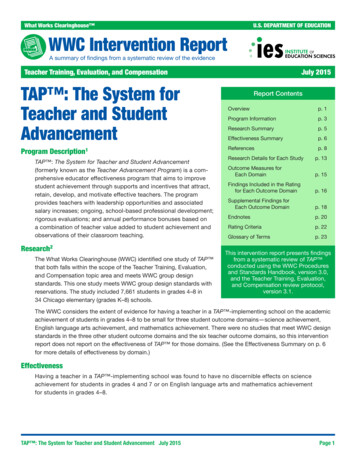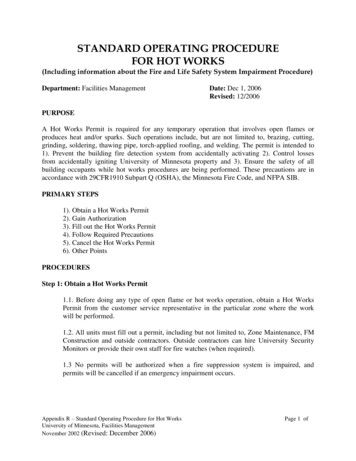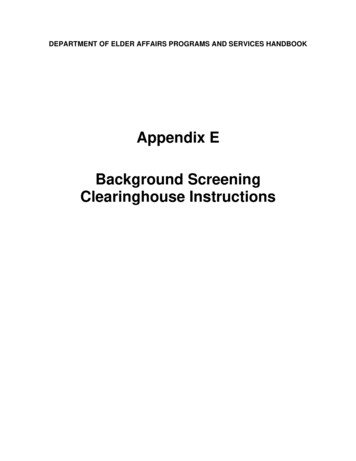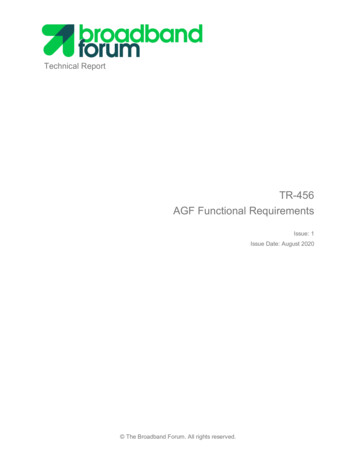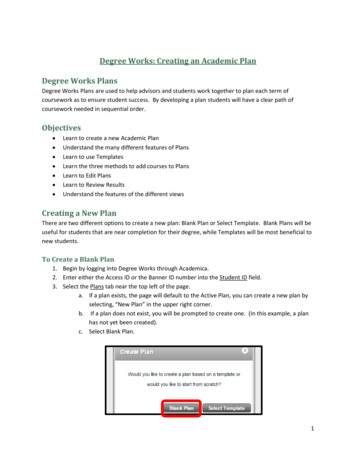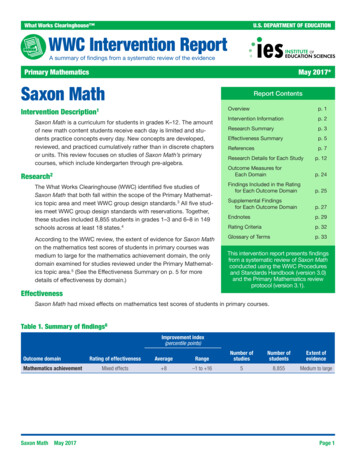
Transcription
What Works Clearinghouse U.S. DEPARTMENT OF EDUCATIONWWC Intervention ReportA summary of findings from a systematic review of the evidencePrimary MathematicsMay 2017*Saxon MathReport ContentsIntervention Description1Saxon Math is a curriculum for students in grades K–12. The amountof new math content students receive each day is limited and students practice concepts every day. New concepts are developed,reviewed, and practiced cumulatively rather than in discrete chaptersor units. This review focuses on studies of Saxon Math’s primarycourses, which include kindergarten through pre-algebra.Overviewp. 1Intervention Informationp. 2Research Summaryp. 3Effectiveness Summaryp. 5Referencesp. 7Research Details for Each Studyp. 12Outcome Measures forEach Domainp. 24The What Works Clearinghouse (WWC) identified five studies ofSaxon Math that both fall within the scope of the Primary Mathematics topic area and meet WWC group design standards.3 All five studies meet WWC group design standards with reservations. Together,these studies included 8,855 students in grades 1–3 and 6–8 in 149schools across at least 18 states.4Findings Included in the Ratingfor Each Outcome Domainp. 25Supplemental Findingsfor Each Outcome Domainp. 27Endnotesp. 29Rating Criteriap. 32According to the WWC review, the extent of evidence for Saxon Mathon the mathematics test scores of students in primary courses wasmedium to large for the mathematics achievement domain, the onlydomain examined for studies reviewed under the Primary Mathematics topic area.5 (See the Effectiveness Summary on p. 5 for moredetails of effectiveness by domain.)Glossary of Termsp. 33Research2EffectivenessThis intervention report presents findingsfrom a systematic review of Saxon Mathconducted using the WWC Proceduresand Standards Handbook (version 3.0)and the Primary Mathematics reviewprotocol (version 3.1).Saxon Math had mixed effects on mathematics test scores of students in primary courses.Table 1. Summary of findings6Improvement index(percentile points)Outcome domainMathematics achievementSaxon MathMay 2017Rating of effectivenessAverageRangeNumber ofstudiesNumber ofstudentsExtent ofevidenceMixed effects 8–1 to 1658,855Medium to largePage 1
WWC Intervention ReportIntervention InformationBackgroundSaxon Math was originally developed by John Saxon. It is distributed by Houghton Mifflin Harcourt SupplementalPublishers. Address: Houghton Mifflin Harcourt Pre-K-12, 9205 Southpark Center Loop, Orlando, FL, 32819. Email:greatservice@hmhco.com. Website: www.hmhco.com. Telephone: (800) 225-5425. Fax: (800) 269-5232.Intervention detailsAt each grade level, Saxon Math consists of at least 120 daily lessons and 12 investigation activities. Each lessonhas three components: The teacher introduces one or more new math ideas daily, using examples and mathematical conversations,with a focus on integrating new ideas and concepts with ones previously introduced. The teacher guides students on practice problems relating to the new concepts. Students individually engage in written practice that aims to help them master new skills and maintain masteryof concepts previously taught.Students complete written, cumulative assessments after every five lessons. The results of these assessments provide teachers with data for instructional decision making and provide feedback for students and parents. Studentsalso have opportunities to demonstrate mastery of math content through in-depth investigations and performancetasks that require students to apply their mathematical knowledge and skills to real-world problems.The primary curriculum includes Saxon Math Primary K-3 and Saxon Math Intermediate 3-5 for elementary grades,and Saxon Math Courses 1, 2, and 3 for grades 6, 7, and 8, respectively. The publisher is currently selling thesecond edition and Common Core edition of Saxon Math. The publisher’s website describes each of these currenteditions of the curriculum.CostAs of November 2016, the costs for curriculum materials were as follows: For Saxon Math Primary K-3, each set of teacher’s materials costs 276.20 to 285.50, and student kits cost 856.90 to 995.05 for 24 students. For Saxon Math Intermediate 3-5, each set of teacher’s materials costs 278.90 for a hard-copy version. Ateacher technology package is available for 175.15 (for a 1-year subscription) and includes the Teacher’sManual eBook and various electronic teacher and planning resources. The student edition costs 19.20 forthe online version for a 1-year subscription, 58.60 for a 6-year online subscription, or 80.40 for the hardcopy version. A combined Saxon Math Intermediate 3-5 online student/teacher edition costs 1,168.85 for a1-year subscription or 5,849.40 for a 6-year subscription. For Saxon Math Courses 1, 2, and 3 (grades 6–8), the teacher’s manual costs 131.75 for a hard copy, 33.30for a 1-year subscription to an online edition, or 99.75 for a 6-year online subscription. The student edition foreach course costs 82.20 per student for a hard copy, 65.75 for an eBook, 20.60 for a 1-year subscription toan online edition, or 61.65 for a 6-year online subscription. A combined Saxon Math Courses 1-3 online student/teacher edition costs 1,168.85 for a 1-year subscription or 5,849.40 for a 6-year subscription.Other materials, such as student workbooks, instructional presentations, and manipulative kits, are available andrange in price. More detailed cost information is available from the publisher.Saxon MathMay 2017Page 2
WWC Intervention ReportResearch SummaryThe WWC identified 26 eligible studies that investigated the effects ofSaxon Math on the mathematics achievement of students in primarycourses. An additional 33 studies were identified but do not meet WWCeligibility criteria (see the Glossary of Terms in this document for a definition of this term and other commonly used research terms) for reviewin this topic area. Citations for all 59 studies are in the References section, which begins on p. 7.Table 2. Scope of reviewed researchGrade1, 2, 3, 6, 7, 8Delivery methodWhole classProgram typeCurriculumThe WWC reviewed the 26 eligible studies against group design standards. None of the 26 studies is a randomizedcontrolled trial that meets WWC group design standards without reservations. One study is a randomized controlledtrial that meets WWC group design standards with reservations, and four studies use quasi-experimental designsthat meet WWC group design standards with reservations. This report summarizes those five studies. The remaining 21 studies do not meet WWC group design standards.Summary of studies meeting WWC group design standards without reservationsNo studies of Saxon Math met WWC group design standards without reservations.Summary of studies meeting WWC group design standards with reservationsAgodini, Harris, Seftor, Remillard, and Thomas (2013) conducted a cluster, or group-based, randomized controlledtrial assigning one of four math curricula—Saxon Math; Investigations in Number, Data, and Space (Investigations);Math Expressions; or Scott-Foresman Addison Wesley Mathematics (SFAW)—to 111 elementary schools in 12school districts to use as their core math curriculum in first and second grades. The 111 schools enrolled in thestudy in either the 2006–07 or 2007–08 school year, and 58 of the schools participated in the study for 2 consecutive years. During the second year of the study, the publisher revised SFAW and renamed it enVisionMATH.The group of schools that used enVisionMATH in the second year is labeled SFAW/enVisionMATH. The studyexamined 1- and 2-year effects of the curricula on student math achievement using the Early Childhood Longitudinal Study–Kindergarten math assessment. The WWC based its effectiveness rating on a finding that compared2-year outcomes in 12 schools that used Saxon Math to those in 46 schools that used other curricula. This sampleincluded 2,045 students in the 58 schools that participated in the study for 2 years. Assumptions about equivalencein random assignment may not hold because schools were randomly assigned to curriculum before the studentsample was identified. Families could know a school’s curriculum assignment and, in theory, could decide to moveinto or out of a school based on that knowledge. The study demonstrated equivalence on the analytic sample andtherefore, meets WWC group design standards with reservations. Findings after 1 year based on all 111 schools areincluded as supplemental findings in Appendix D. The study did not specify the edition of Saxon Math it used, butindicated that the materials were copyrighted in 2005 and 2008.Crawford and Raia (1986) used a quasi-experimental design to examine the effects of Saxon Math on eighthgrade students in four middle schools in one school district in the 1984–85 school year.7 Four eighth-grade teachers in the study schools taught at least one class using Saxon Math and at least one class using Scott-ForesmanMathematics. The authors grouped 78 students into 39 pairs. Each pair included two students with similar pretestmath scores, one student in a Saxon Math class and one in a Scott-Foresman Mathematics class taught by thesame teacher. The study used the California Achievement Test math assessment to measure eighth-grade studentachievement. The study did not specify the edition of Saxon Math it used, but indicated that the materials werecopyrighted in 1983.Saxon MathMay 2017Page 3
WWC Intervention ReportGood, Bickel, and Howley (2006) used a quasi-experimental design to compare 33 schools implementing SaxonMath to 24 schools using a variety of other math curricula in the 2005–06 school year. The study randomly selectedintervention group schools, located in 16 states, from all schools in the United States implementing Saxon Math.The authors matched comparison schools to intervention schools based on school characteristics, including schoolsize, percentage of students eligible for free or reduced-price meals, racial and ethnic makeup of the students, andschool Title I status. Within each study school, students in K–3 classrooms participated in the study. The authorsused the Math Problem Solving subtest of the Stanford Achievement Test, Ninth Edition, as the outcome measure,which they administered to students in grades 2 and 3. The sample used for study analysis included 745 secondand third-grade students (411 in 33 intervention schools and 334 in 24 comparison schools).8 The study did notspecify the edition of Saxon Math it used.Resendez, Fahmy, and Manley (2005, Sample 1) used a quasi-experimental design to compare schools implementing Saxon Math in grades 6–8 to schools using other math curricula with a chapter-based approach to mathinstruction.9 The study matched comparison schools to the intervention schools based on demographic characteristics including race, ethnicity, poverty, English language proficiency, and percentage of mobile students (thatis, students who transfer frequently between schools during the school year). The analytic sample included 1,472students from 12 intervention schools who used Saxon Math for 2 years in grades 6 and 7, and 1,582 students from13 comparison schools in the same grades during the 1998–99 and 1999–2000 school years. The study measuredstudent achievement in grades 6 and 7 using the Texas Assessment of Academic Skills Texas Learning Index. Thestudy did not specify the edition of Saxon Math it used.Resendez, Fahmy, and Manley (2005, Sample 3) used a quasi-experimental design to compare schools implementing Saxon Math in grades 6–8 to schools using other math curricula with a chapter-based approach to mathinstruction. The study matched comparison schools to the intervention schools based on demographic characteristics including race, ethnicity, poverty, English language proficiency, and percentage of mobile students. The analyticsample included 1,526 students from 10 intervention schools who used Saxon Math in grade 6, and 1,407 studentsfrom 10 comparison schools in the same grade during the 2003–04 school year. The authors measured studentachievement in grade 6 using the Texas Assessment of Knowledge and Skills math scale score. The study did notspecify the edition of Saxon Math it used.Saxon MathMay 2017Page 4
WWC Intervention ReportEffectiveness SummaryThe WWC review of Saxon Math for the Primary Mathematics topic area includes student outcomes in one domain:mathematics achievement. The following findings present the authors’ estimates and WWC-calculated estimatesof the size and statistical significance of the effects of Saxon Math on mathematics achievement for students inprimary courses. Additional comparisons are available as supplemental findings in Appendix D. The supplementalfindings do not factor into the intervention’s rating of effectiveness. For a more detailed description of the rating ofeffectiveness and extent of evidence criteria, see the WWC Rating Criteria on p. 32.Summary of effectiveness for the mathematics achievement domainTable 3. Rating of effectiveness and extent of evidence for the mathematics achievement domainRating of effectivenessCriteria metMixed effectsEvidence of inconsistent effects.In the five studies that reported findings, the estimated impact of the intervention on outcomes in the mathematicsachievement domain was positive and substantively important in two studies and indeterminate in three studies.Extent of evidenceCriteria metMedium to largeFive studies that included 8,855 students in 149 schools across at least 18 states reported evidence of effectiveness in the mathematics achievement domain.Five studies that met WWC group design standards with reservations reported findings in the mathematics achievement domain.Agodini et al. (2013) compared Saxon Math against each of the three other curricula. The authors reported, andthe WWC confirmed, a positive and statistically significant difference between Saxon Math and Investigations, oneof the three comparison group curricula, in the mathematics achievement domain. The authors reported, and theWWC confirmed, no statistically significant or substantively important differences between Saxon Math and theother two curricula (Math Expressions and SFAW/enVisionMATH). For the purposes of providing an overall rating ofeffectiveness, the WWC pooled the three comparison curricula groups and compared the pooled group to SaxonMath; the WWC found the difference was neither statistically significant nor substantively important. The WWCcharacterizes this study finding as an indeterminate effect.Crawford and Raia (1986) reported a positive and statistically significant difference between Saxon Math and the comparison group in the mathematics achievement domain. However, after correcting for clustering, the WWC found thatthis difference was not statistically significant. The effect size is large enough to be considered substantively importantaccording to WWC criteria. The WWC characterizes this study finding as a substantively important positive effect.Good et al. (2006) reported a positive difference between Saxon Math and the comparison group in the mathematics achievement domain. The study did not report the statistical significance of this finding. After correcting forschool clustering, the WWC found that the difference was neither statistically significant nor substantively important. The WWC characterizes this study finding as an indeterminate effect.Resendez et al. (2005, Sample 1) reported a positive difference between Saxon Math and the comparison group inthe mathematics achievement domain. The authors did not report the statistical significance of this finding. Aftercorrecting for school clustering, the WWC found that the difference was neither statistically significant nor substantively important. The WWC characterizes this study finding as an indeterminate effect.Saxon MathMay 2017Page 5
WWC Intervention ReportResendez et al. (2005, Sample 3) reported a positive and statistically significant difference between Saxon Mathand the comparison group in the mathematics achievement domain. However, after correcting for school clustering,the WWC found that this difference was not statistically significant. The effect size is large enough to be consideredsubstantively important according to WWC criteria. The WWC characterizes this study finding as a substantivelyimportant positive effect.Thus, for the mathematics achievement domain, two studies show substantively important positive effects and threestudies show indeterminate effects. This results in a rating of mixed effects, with a medium to large extent of evidence.Saxon MathMay 2017Page 6
WWC Intervention ReportReferencesStudies that meet WWC group design standards without reservationsNone.Studies that meet WWC group design standards with reservationsAgodini, R., Harris, B., Seftor, N., Remillard, J., & Thomas, M. (2013). After two years, three elementary math curricula outperform a fourth (NCEE 2013-4019). Washington, DC: National Center for Education Evaluation andRegional Assistance, Institute of Education Sciences, U.S. Department of Education. Retrieved from https://eric.ed.gov/?&id ED544185Additional sources:Agodini, R., & Harris, B. (2010). An experimental evaluation of four elementary school math curricula. Journalof Research on Educational Effectiveness, 3(3), 199–253.Agodini, R., Harris, B., Atkins-Burnett, S., Heaviside, S., Novak, T., & Murphy, R. (2009). Achievement effectsof four early elementary school math curricula: Findings from first graders in 39 schools (NCEE 20094052). Washington, DC: National Center for Education Evaluation and Regional Assistance, Institute ofEducation Sciences, U.S. Department of Education. Retrieved from https://eric.ed.gov/?&id ED504418Agodini, R., Harris, B., Seftor, N., Remillard, J., & Thomas, M. (2013). Technical appendix: After two years,three elementary math curricula outperform a fourth (NCEE 2013-4019). Washington, DC: National Center for Education Evaluation and Regional Assistance, Institute of Education Sciences, U.S. Departmentof Education. Retrieved from https://eric.ed.gov/?&id ED544187Agodini, R., Harris, B., Thomas, M., Murphy, R., & Gallagher, L. (2010). Achievement effects of four earlyelementary school math curricula: Findings for first and second graders (NCEE 2011-4001). Washington,DC: National Center for Education Evaluation and Regional Assistance, Institute of Education Sciences,U.S. Department of Education. Retrieved from https://eric.ed.gov/?&id ED512551Clements, D. H., Agodini, R., & Harris, B. (2013). Instructional practices and student math achievement: Correlations from a study of math curricula (NCEE 2013-4020). Washington, DC: National Center for Education Evaluation and Regional Assistance, Institute of Education Sciences, U.S. Department of Education.Retrieved from https://eric.ed.gov/?&id ED544189Clements, D. H., Agodini, R., & Harris, B. (2013). Technical appendix: Data and methodological approach(NCEE 2013-4020). Washington, DC: National Center for Education Evaluation and Regional Assistance, Institute of Education Sciences, U.S. Department of Education. Retrieved from https://eric.ed.gov/?&id ED544192Remillard, J. T., Harris, B., & Agodini, R. (2014). The influence of curriculum material design on opportunitiesfor student learning. ZDM: The International Journal on Mathematics Education, 46(5), 735–749.Crawford, J., & Raia, F. (1986). Analyses of eighth grade math texts and achievement. Oklahoma City, OK: Oklahoma City Public Schools Planning, Research, and Evaluation Department.Good, K., Bickel, R., & Howley, C. (2006). Saxon Elementary Math Program effectiveness study. Charlestown, WV:Edvantia, Inc.Resendez, M., Fahmy, A., & Manley, M. A. (2005). The relationship between using Saxon Middle School Math andstudent performance on Texas statewide assessments [Sample 1]. Jackson, WY: PRES Associates, Inc.Resendez, M., Fahmy, A., & Manley, M. A. (2005). The relationship between using Saxon Middle School Math andstudent performance on Texas statewide assessments [Sample 3]. Jackson, WY: PRES Associates, Inc.Studies that do not meet WWC group design standardsBaldree, C. L. P. (2003). The effectiveness of two mathematical instructional programs on the mathematics growth ofeighth grade students (Unpublished doctoral dissertation). University of Georgia, Athens. The study does notSaxon MathMay 2017Page 7
WWC Intervention Reportmeet WWC group design standards because equivalence of the analytic intervention and comparison groupsis necessary and not demonstrated.Bell, G. (2012). The effects of Saxon Math instruction on middle school students’ mathematics achievement. Dissertation Abstracts International Section A: Humanities and Social Sciences, 73(4-A), 1339. The study does notmeet WWC group design standards because equivalence of the analytic intervention and comparison groupsis necessary and not demonstrated.Bhatt, R., & Koedel, C. (2012). Large-scale evaluations of curricular effectiveness: The case of elementary mathematics in Indiana. Educational Evaluation and Policy Analysis, 34(4), 391–412. The study does not meet WWCgroup design standards because equivalence of the analytic intervention and comparison groups is necessaryand not demonstrated.Calvery, R., Bell, D., & Wheeler, G. (1993). A comparison of selected second and third graders’ math achievement:Saxon vs. Holt. New Orleans, LA: Mid-South Educational Research Association. The study does not meetWWC group design standards because equivalence of the analytic intervention and comparison groups isnecessary and not demonstrated.Cummins-Colburn, B. J. L. (2007). Differences between state-adopted textbooks and student outcomes on theTexas Assessment of Knowledge and Skills examination. Dissertation Abstracts International, 68(06A), 1682299. The study does not meet WWC group design standards because equivalence of the analytic intervention and comparison groups is necessary and not demonstrated.Educational Research Institute of America. (2009). A longitudinal analysis of state mathematics scores for Indianaschools using Saxon Math (Report No. 362). Bloomington, IN: Author. The study does not meet WWC groupdesign standards because the measures of effectiveness cannot be attributed solely to the intervention.Fahsl, A. J. (2001). An investigation of the effects of exposure to Saxon Math textbooks, socioeconomic status andgender on math achievement scores. Dissertation Abstracts International, 62(08), 2681A. The study does notmeet WWC group design standards because equivalence of the analytic intervention and comparison groupsis necessary and not demonstrated.Hansen, E., & Greene, K. (2000). A recipe for math. What’s cooking in the classroom: Saxon or traditional? Thestudy does not meet WWC group design standards because the measures of effectiveness cannot be attributed solely to the intervention.Hook, W., Bishop, W., & Hook, J. (2007). A quality math curriculum in support of effective teaching for elementaryschools. Educational Studies in Mathematics, 65(2), 125–148. The study does not meet WWC group designstandards because equivalence of the analytic intervention and comparison groups is necessary and notdemonstrated.Lafferty, J. F. (1996). The links among mathematics text, students’ achievement, and students’ mathematics anxiety: A comparison of the incremental development and traditional texts. Dissertation Abstracts International,56(08), 3014A. The study does not meet WWC group design standards because the measures of effectiveness cannot be attributed solely to the intervention.Additional source:Lafferty, J. F. (1994). The links among mathematics text, students’ achievement, and students’ mathematicsanxiety: A comparison of the incremental development and traditional texts (Unpublished doctoral dissertation). Widener University, Chester, PA.Nguyen, K., Elam, P., & Weeter, R. (1993). The 1992-93 Saxon Mathematics Program evaluation report. OklahomaCity, OK: Oklahoma City Public Schools. The study does not meet WWC group design standards becauseequivalence of the analytic intervention and comparison groups is necessary and not demonstrated.Rentschler, R. V. (1994). The effects of Saxon’s incremental review on computational skills and problem-solving achievement of sixth-grade students. Dissertation Abstracts International, 56(2), 484A. The study does not meet WWCgroup design standards because the measures of effectiveness cannot be attributed solely to the intervention.Saxon MathMay 2017Page 8
WWC Intervention ReportResendez, M., & Azin, M. (2006). Saxon Math randomized control trial: Final report. Jackson, WY: PRES Associates,Inc. The study does not meet WWC group design standards because equivalence of the analytic interventionand comparison groups is necessary and not demonstrated.Resendez, M., & Azin, M. (2007). The relationship between using Saxon Elementary and Middle School Math andstudent performance on California statewide assessments. Jackson, WY: PRES Associates, Inc. The studydoes not meet WWC group design standards because equivalence of the analytic intervention and comparison groups is necessary and not demonstrated.Additional source:Resendez, M., & Azin, M. (2007). Saxon Math and California English Learner’s math performance: Researchbrief. Jackson, WY: PRES Associates, Inc.Resendez, M., & Azin, M. (2008). The relationship between using Saxon Math at the elementary and middle schoollevels and student performance on the North Carolina statewide assessment: Final report. Jackson, WY: PRESAssociates, Inc. The study does not meet WWC group design standards because equivalence of the analyticintervention and comparison groups is necessary and not demonstrated.Resendez, M., & Azin Manley, M. (2005). The relationship between using Saxon Elementary and Middle School Mathand student performance on Georgia statewide assessments. Jackson, WY: PRES Associates, Inc. The studydoes not meet WWC group design standards because equivalence of the analytic intervention and comparison groups is necessary and not demonstrated.Resendez, M., Sridiharan, S., & Azin, M. (2006). The relationship between using Saxon Elementary School Math andstudent performance on Texas statewide assessments. Jackson, WY: PRES Associates, Inc. The study doesnot meet WWC group design standards because equivalence of the analytic intervention and comparisongroups is necessary and not demonstrated.Roan, C. (2012). A comparison of elementary mathematics achievement in Everyday Math and Saxon Math schoolsin Illinois (Doctoral dissertation). Available from ProQuest Dissertations and Theses database. (UMI No.3507509) The study does not meet WWC group design standards because equivalence of the analytic intervention and comparison groups is necessary and not demonstrated.Roberts, F. H. (1994). The impact of Saxon Mathematics Program on group achievement test scores. DissertationAbstracts International, 55(06), 1498A. The study does not meet WWC group design standards because themeasures of effectiveness cannot be attributed solely to the intervention.Severns, L. D. (2014). Saxon Math and student achievement: A multiyear investigation (Doctoral dissertation).Available from ProQuest Dissertations and Theses database. (UMI No. 1662809559) The study does notmeet WWC group design standards because the measures of effectiveness cannot be attributed solely to theintervention.Additional source:Severns, L. D. (2014). Differences in grade 8 students’ math achievement as a function of Saxon Math instruction. The Online Journal of New Horizons in Education, 4(4), 20–26.Walsh, T. J. (2009). The effect of Saxon Math on student achievement of sixth-grade students. DissertationAbstracts International, 70(06A), 135-1966. The study does not meet WWC group design standards becausethe measures of effectiveness cannot be attributed solely to the intervention.Studies that are ineligible for review using the Primary Mathematics Evidence Review ProtocolAbrams, B. J. (1989). A comparison study of the Saxon Algebra 1 text (Unpublished doctoral dissertation). University of Colorado at Boulder. The study is ineligible for review because it is out of scope of the protocol.Andrus, H. A. (2005). Metacognitive instruction in the realm of sixth grade Saxon Math (Unpublished doctoral dissertation). Mount Mary College, Milwaukee, WI. The study is ineligible for review because it does not use aneligible design.Saxon MathMay 2017Page 9
WWC Intervention ReportAquino, A., & Zoet, C. (1985). Reinforcement in Algebra I: A study in the use of the Saxon Algebra I textbook. Mathematics in Michigan, 23–28. The study is ineligible for review because it is out of scope of the protocol.Baroody, A. J., Purpura, D. J., Eiland, M. D., & Reid, E. E. (2014). Fostering first graders’ fluency with basic subtraction and larger addition combinations via computer-assisted instruction. Cognition and Instruction, 32(2),159–197. The study is ineligible for review because it is out of scope of the protocol.Bolser, S., & Gilman, D. A. (2003). Saxon Math, Southeast Fountain Elementary School: Effective or ineffective?Retrieved from https://eric.ed.gov/?&id ED474537 The study is ineligible for review because it does not usean eligible design.Christofori, P. (2005). The effect of direct instruction math curriculum on higher-order problem solving (Unpublisheddoctoral dissertation). University of South Florida. The study is ineligible for review because it is out of scopeof the protocol.Clay, D. W. (1998). A study to determine the effects of a non-traditional approach to algebra instruction on studentachievement (Unpublished master’s thesis). Salem-Teikyo University, Salem, WV. Retrieved from https://eric.ed.gov/?&id ED428963 The study is ineligible for review because it is out of scope of the protocol.Clewell, B. C., Cosentino de Cohen, C., Campbell, P. B., & Perlman, L. (2005). Review
The primary curriculum includes Saxon Math Primary K-3 and Saxon Math Intermediate 3-5 for elementary grades, and Saxon Math Courses 1, 2, and 3 for grades 6, 7, and 8, respectively. The publisher is currently selling the second edition and Common Core edition of Saxon Math. The publisher’s website describes each of these currentFile Size: 807KBPage Count: 36

